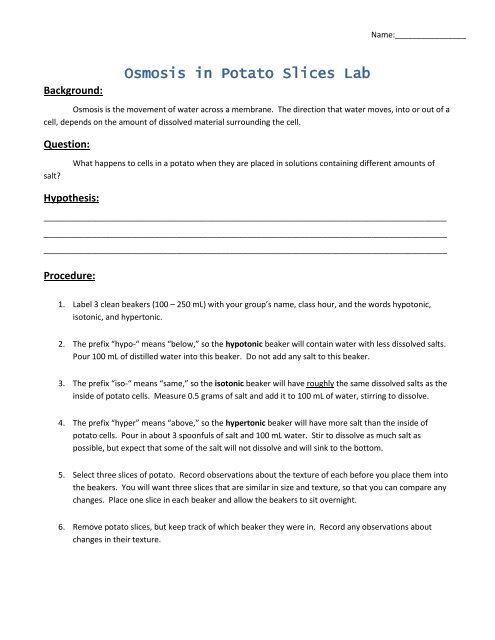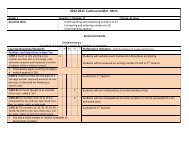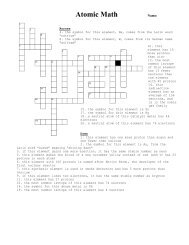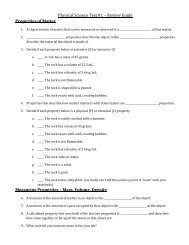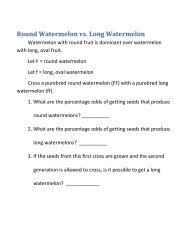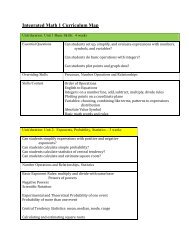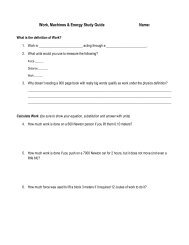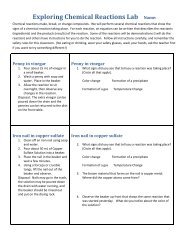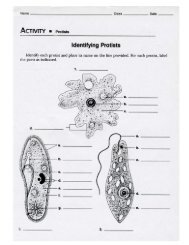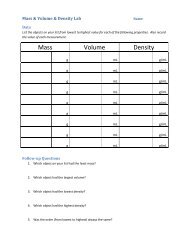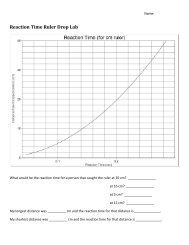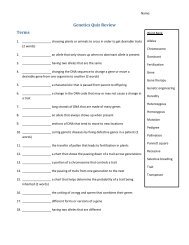Osmosis in Potato Slices Lab
Osmosis in Potato Slices Lab
Osmosis in Potato Slices Lab
You also want an ePaper? Increase the reach of your titles
YUMPU automatically turns print PDFs into web optimized ePapers that Google loves.
Name:________________<br />
Background:<br />
<strong>Osmosis</strong> <strong>in</strong> <strong>Potato</strong> <strong>Slices</strong> <strong>Lab</strong><br />
<strong>Osmosis</strong> is the movement of water across a membrane. The direction that water moves, <strong>in</strong>to or out of a<br />
cell, depends on the amount of dissolved material surround<strong>in</strong>g the cell.<br />
Question:<br />
salt?<br />
What happens to cells <strong>in</strong> a potato when they are placed <strong>in</strong> solutions conta<strong>in</strong><strong>in</strong>g different amounts of<br />
Hypothesis:<br />
___________________________________________________________________________________________<br />
___________________________________________________________________________________________<br />
___________________________________________________________________________________________<br />
Procedure:<br />
1. <strong>Lab</strong>el 3 clean beakers (100 – 250 mL) with your group’s name, class hour, and the words hypotonic,<br />
isotonic, and hypertonic.<br />
2. The prefix “hypo-“ means “below,” so the hypotonic beaker will conta<strong>in</strong> water with less dissolved salts.<br />
Pour 100 mL of distilled water <strong>in</strong>to this beaker. Do not add any salt to this beaker.<br />
3. The prefix “iso-“ means “same,” so the isotonic beaker will have roughly the same dissolved salts as the<br />
<strong>in</strong>side of potato cells. Measure 0.5 grams of salt and add it to 100 mL of water, stirr<strong>in</strong>g to dissolve.<br />
4. The prefix “hyper” means “above,” so the hypertonic beaker will have more salt than the <strong>in</strong>side of<br />
potato cells. Pour <strong>in</strong> about 3 spoonfuls of salt and 100 mL water. Stir to dissolve as much salt as<br />
possible, but expect that some of the salt will not dissolve and will s<strong>in</strong>k to the bottom.<br />
5. Select three slices of potato. Record observations about the texture of each before you place them <strong>in</strong>to<br />
the beakers. You will want three slices that are similar <strong>in</strong> size and texture, so that you can compare any<br />
changes. Place one slice <strong>in</strong> each beaker and allow the beakers to sit overnight.<br />
6. Remove potato slices, but keep track of which beaker they were <strong>in</strong>. Record any observations about<br />
changes <strong>in</strong> their texture.
Data:<br />
Type of<br />
Solution<br />
Amount of Salt<br />
(per 100 mL<br />
water)<br />
Texture of <strong>Potato</strong> Slice<br />
BEFORE<br />
Texture of <strong>Potato</strong> Slice<br />
AFTER<br />
Hypotonic<br />
None<br />
Isotonic<br />
0.5 g<br />
Hypertonic<br />
Lots<br />
Results:<br />
The potato slice <strong>in</strong> the __________ solution became more ___________,<br />
while the potato slice <strong>in</strong> the ___________ solution became more<br />
_____________.<br />
Conclusion:<br />
Write a paragraph to expla<strong>in</strong> why the potato slices changed <strong>in</strong> texture. Th<strong>in</strong>k about what happened to the cells.<br />
You will want to use the follow<strong>in</strong>g words <strong>in</strong> your explanation: water, cell membrane, flow, hypotonic,<br />
hypertonic, isotonic, solution. Use your best spell<strong>in</strong>g, grammar, and sentence structure.<br />
___________________________________________________________________________________________<br />
___________________________________________________________________________________________<br />
___________________________________________________________________________________________<br />
___________________________________________________________________________________________<br />
___________________________________________________________________________________________<br />
___________________________________________________________________________________________<br />
___________________________________________________________________________________________<br />
___________________________________________________________________________________________<br />
___________________________________________________________________________________________<br />
___________________________________________________________________________________________<br />
___________________________________________________________________________________________<br />
___________________________________________________________________________________________<br />
___________________________________________________________________________________________<br />
___________________________________________________________________________________________<br />
___________________________________________________________________________________________<br />
___________________________________________________________________________________________


